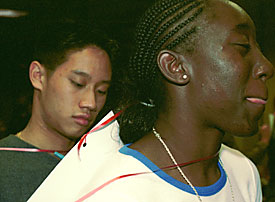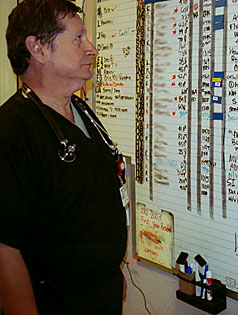 |
|
EMILY REID/Arizona Daily Wildcat
|
For an exercise as part of their Individuals and Societies 101 class last Tuesday night, communications engineering sophomore Andrew Lin writes comments about business freshman and women's basketball player CoCoa Sanford on a piece of paper on her back.
|
|
By Keren G. Raz
Arizona Daily Wildcat
Tuesday December 10, 2002
UA debates faculty diversity as Supreme Court decides role of race in admissions
When Terry Valenzuela, professor of emergency medicine, wants to illustrate why he thinks the UA is unbalanced in its hiring practices, he shows a video.
On the tape, a medical student takes center stage in front of a large auditorium of people, then he sits down and belts out a song about the past four years and his views on Hispanic women.
"Well, she's only 18, and she's got five children all on the public's green. There's a new guy in town and when his pants come down, he'll be the father of her next baby," the student sings.
As one of the only Mexican-American professors in the College of Medicine, Valenzuela said he has witnessed discrimination against Hispanics.
 |
|
ALYSON GROVE/Arizona Daily Wildcat
|
Dr. Terrence D. Valenzuela, a professor in the emergency medicine department, says the UA needs to broaden faculty diversity, which he says includes knowledge of cultural issues.
|
|
But Valenzuela doesn't blame
students. He blames university administration's failure to make its faculty more diverse.
Students aren't becoming culturally aware because those who educate them aren't culturally diverse, he said.
In October, President Pete Likins released UA's plan to increase diversity. Dubbed the "Diversity Action Plan," the plan lists 87 short- and long-term goals that seek to make campus more diverse.
However, for Valenzuela, the administration's efforts leave too many questions unanswered.
"I think what's missing is how exactly are we going to do it. How do we know what we mean by diversity, and how do we know when we get there?" he said.
Valenzuela's take on the new plan was voiced by many others at a town hall last month, at which officials avoided providing specifics about the plan.
Now, the details are slowly unraveling as the administration pushes its plan ÷ and the debate is heating up.
 |
|
EMILY REID/Arizona Daily Wildcat
|
Mike Darragh, an undecided sophomore, writes positive comments on a fellow student's paper as part of an activity during his INDV 101 class, Interpersonal Communication in the Daily World, Tuesday night. All students in the class participated in writing anonymous comments to one another.
|
|
Pinning down a definition
Two years ago, the North Central Association, the group that accredits the UA, reported that the university would have to diversify its faculty in order to keep its accreditation. Right now, the UA has 189 minority faculty and 427 female faculty out of a total 1,564, according to university statistics.
In 2003, the NCA will review the UA once again to see if administrators have a credible plan.
But although diversity has become the newest buzz-word, no one can agree on what it means. To Valenzuela, diversity means knowledge of cultural issues.
To Libby Ervin, the vice provost for academic affairs, diversity can include differences in teaching style.
The Diversity Action Plan, which Likins revealed last month, takes an entire paragraph to define what diversity means ÷ but few people seem to understand it.
This is one of the fundamental problems with the plan, said Chuck Tatum, dean of the Humanities College and chair of the dean's diversity subcommittee.
"I don't want diversity being interpreted so broadly in recruitment and retention of diverse faculty that it has no meaning at all," he said.
Although the meaning of diversity may be ambiguous, Patti Ota, vice president for executive affairs, defines diversity in much narrower terms when it comes to the recruitment and retention of diverse faculty.
"When I'm talking about making faculty more diverse, we're really talking about race, culture, gender, disability and sexual orientation," Ota said. "If we bring in people diverse in these ways, we bring in differences."
However, Stuart Cohen, associate dean of research in the College of Public Health, said that the plan should address a more comprehensive view of diversity. "The plan focuses on race, gender and ethnicity because those are acceptable categories of diversity, but not sexual orientation because that's not an acceptable category here," he said. "We need to consider other areas of diversity such as age, disability and gender identity."
A national debate hits home
The national diversity trend in higher education, which some claim uses diversity as a justification for racial preferences, and the conspicuous absence of its definition has opened the door for criticism.
Marianne Jennings, professor of law at ASU and the president of the Arizona Association of Scholars, a university watch-dog group, said she absolutely stands against any diversity plan that focuses on race and ethnicity.
"Anytime you're in an educational environment and you seek to stereotype, diversify and fill quotas, it's ridiculous," she said. "Hostility breeds when classifying people by race, no matter the best of intentions."
Curt Levey, director of legal and public affairs from the Center for Individual Rights, said that diversity should be about intellectual diversity, pointing to the need for liberal and conservative faculty.
"I think genuine intellectual diversity is
a good thing, but that's not what the universities are really about. They're about racial diversity," he said. "And that's not legal by any means."
But Provost George Davis said a narrower definition that focuses on race and ethnicity is important because it is what accreditors are looking for.
"The North Central Association is primarily concerned with underrepresented minority groups, African-American, Native-American and Hispanic. Our recruitment tries to go after those minority groups," Davis said.
Last week, the Supreme Court decided to review a case that will decide whether the University of Michigan is justified in using race as a factor in its admission evaluations. The Center for Individual Rights is defending three white students who were denied entry to the school. It will be arguing against affirmative action and diversity on campus in front of the Supreme Court next year.
Likins said that the administration is watching this case closely and supporting Michigan. But he said that the UA's plan was written to avoid being illegal under a possible ruling from the Supreme Court, avoiding quotas on race and gender.
Implementing the plan
Socorro Carrizosa, director of Hispano-Chicano student affairs, said she feels like she keeps asking the same questions over and over again.
"Many of these questions have been asked for years," she said.
She wants to know what kinds of strategies will recruit more Hispanic students.
"How will deans be held accountable in recruiting Hispanic faculty and keeping them on track for tenure?" she said. "Until the president's ready to tell us · how he's going to move forward with the plan, we don't have more information, and we'll keep asking the same questions."
There is no timeline for implementing the plan and exact responsibilities within it are still being ironed out by administrators.
Nevertheless, the deans and the provost have already begun taking steps to improve the diversity of the faculty. As the overseer of every part of the plan that deals with recruitment and retention of faculty, Davis said that he began working on diversifying faculty two years ago.
"The last two years, I've been investing in a retention fund of about $700,000 for retaining faculty, with the emphasis on retaining diverse faculty," Davis said.
Since then, retention of minority faculty has jumped up to about 70 percent from 20 percent. Davis said that he will evaluate an administrator's commitment to diversity when he reviews their job performance. Despite the severe budget cuts all departments are facing, administrators are trying to protect and push diversity forward.
"We are trying to protect diversity and crisis management budgets," said Ota.
Saunie Taylor, vice president for Campus Life, is one of the key players in the diversity plan, as she oversees the multicultural centers. The multicultural centers are only receiving a 3 percent to 3.5 percent cut while most other departments under Campus Life, like health and wellness, the student union, and UApresents, will receive a 10 percent cut.
Administrators have also begun placing a new emphasis on searches that will result in many diverse candidates by diversifying the members of the search committee and allowing more room for search committees to seek out diverse candidates.
Fernando Martinez, director of the Arizona Respiratory Center, is the chair of the search for a new College of Medicine dean.
"I have an objective, which is to get a much better representation of talented people out there among the pool," he said. "We need to start taking action and stop talking."
Martinez said he wants his pool of candidates to consist of 10 percent to 20 percent women.
"Many people who belong to a minority or underrepresented group don't think they are eligible because they have given up, probably because they were considered inadequate by others," he said.
In order to reach out to these individuals, Martinez said he has asked members of his committee to call qualified minority and female candidates who may not think they are eligible for a dean position.
If search committees such as Martinez's do not reach and recruit a qualified pool of candidates, they would have to disband their search and start over.
"The provost is looking at hires the college wants to make and if in fact they are not diverse pools, and if all the hires are white men, then he won't allow the hires," Ervin said.
This year, the humanities college hired nine new faculty members, including six women, two Hispanics, one African-American and one Japanese-American, Tatum said.
Next semester, the College of Fine Arts will have a new Native American professor who will be teaching indigenous art history, said Dean Maurice Sevigny. This year, the electrical engineering department was able to hire a female faculty member, said Tom Peterson, dean of the College of Engineering.
Jennings said all searches that seek out minorities are racist because they categorize applicants by stereotypes.
"To think that Hispanics and whites don't think alike is fundamentally racist," she said. "We think we have to create these crazy categories of race, but what we need is an environment that raises issues that are controversial."
Still, Ota said there will be an intellectually diverse environment once administrators focus on attracting faculty who are diverse in race, gender, sexual orientation and disability.
"We won't get diversity of ideas in a homogeneous population," she said.
But Valenzuela said he doesn't expect to see a significant increase in diversity any time soon.
"A university is like an aircraft carrier. It's hard to turn around," he said.

